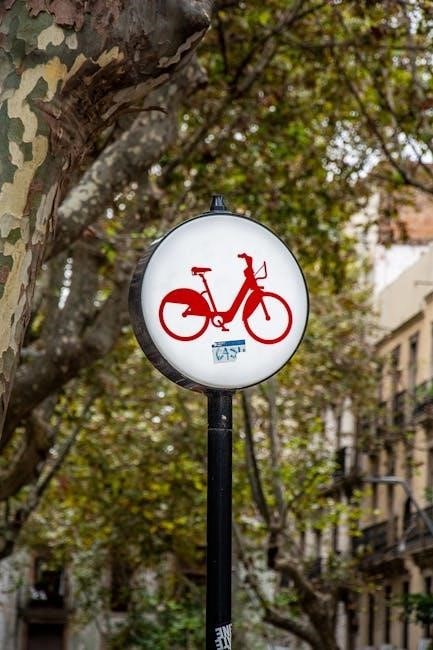
schwinn bike size guide
Schwinn Bike Size Guide: Finding the Perfect Fit
Finding the perfect Schwinn bike size is crucial for a comfortable and efficient riding experience. This guide aims to simplify the process, offering insights into Schwinn’s sizing philosophy and detailed charts for various bike types. Selecting the right size ensures optimal performance, comfort, and safety on every ride.
Choosing the correct bike size is paramount to enjoying a safe, comfortable, and efficient cycling experience. A bike that’s too large or too small can lead to discomfort, pain, and even injury. It affects your posture, control, and overall riding performance. With Schwinn bikes, selecting the right size is particularly important to harness the full potential of their well-engineered designs.
A properly sized bike allows for optimal power transfer, making pedaling more efficient and reducing fatigue. It also ensures better handling and stability, especially on varied terrains. Ignoring bike size can result in back pain, knee problems, and wrist strain, hindering your enjoyment and potentially leading to long-term health issues. Whether you’re cruising around the neighborhood, tackling mountain trails, or embarking on a long road ride, the right bike size is the foundation for a positive cycling experience.
Schwinn offers a diverse range of bikes, each designed for specific purposes. Understanding the importance of bike size and utilizing Schwinn’s sizing guides will help you find the perfect fit, maximizing your comfort, performance, and overall enjoyment of cycling. Don’t underestimate the impact of bike size; it’s the key to unlocking a world of cycling adventures.
Understanding Schwinn’s Sizing Philosophy
Schwinn’s sizing philosophy revolves around providing bikes that cater to a wide range of riders, ensuring everyone can find a comfortable and efficient fit. They achieve this through detailed size charts specific to each bike type, considering factors like rider height and inseam. Schwinn recognizes that bike size isn’t a one-size-fits-all approach, and their models are designed with variations to accommodate individual body proportions and riding styles.

Their sizing guides often categorize bikes into small, medium, large, and extra-large frames, providing a clear starting point for riders. Schwinn also acknowledges the importance of wheel size, particularly for adult bikes where single frame sizes might be paired with different wheel diameters. This approach allows for fine-tuning the fit based on rider preference and intended use.
Furthermore, Schwinn understands that sizing can be a personal preference. They encourage riders to consult geometry charts and, if possible, test ride different sizes to find the perfect match. Schwinn’s commitment to inclusivity extends to kids’ bikes, with SmartStart technology designed to better fit children’s proportions, ensuring a comfortable and confidence-boosting riding experience from a young age. By prioritizing rider comfort and offering comprehensive sizing resources, Schwinn aims to make cycling accessible and enjoyable for everyone.

Schwinn Bike Size Charts: An Overview
Schwinn provides specific size charts tailored to each bike category, simplifying the selection process. These charts act as a crucial starting point, correlating rider height with appropriate frame sizes for road, mountain, hybrid, and cruiser bikes. Each chart considers the unique geometry and intended use of the specific bike type, ensuring a more precise fit recommendation.
The charts typically present a range of heights associated with each frame size (e.g., Small, Medium, Large), enabling riders to quickly identify potential matches. However, Schwinn emphasizes that these charts are guidelines, and individual body proportions and riding preferences should also influence the final decision. For instance, riders with longer torsos might prefer a larger frame, while those seeking a more aggressive riding position might opt for a smaller one.
In addition to height-based recommendations, some charts might include inseam measurements for greater accuracy, particularly for road and mountain bikes. It’s important to consult the specific chart for your chosen bike model, as sizing can vary slightly between different Schwinn series. These charts are readily available on Schwinn’s website and often included in product descriptions, empowering customers to make informed decisions and find the perfect fit for their cycling needs. Furthermore, remember that professional fitting at a local bike shop is invaluable.
Road Bike Size Chart
Schwinn’s road bike size chart is designed to help you find the ideal frame size for optimal performance and comfort on paved surfaces. Road bikes prioritize efficiency and aerodynamics, so a proper fit is crucial for maximizing power transfer and minimizing strain. The chart typically uses rider height as the primary determinant of frame size, providing a range of recommended sizes for different height brackets.
However, inseam length also plays a significant role in road bike sizing. A longer inseam might necessitate a larger frame to ensure adequate leg extension during pedaling, while a shorter inseam could indicate a smaller frame for better standover clearance. Schwinn’s road bike size chart often includes inseam guidelines to refine the fitting process.

It’s important to note that road bike sizing can be more precise than other bike types due to the emphasis on performance. Factors like flexibility, riding style, and personal preference can also influence the ideal frame size. Some riders prefer a more aggressive, aerodynamic position with a smaller frame, while others prioritize comfort and stability with a slightly larger frame. Consulting with a professional bike fitter is highly recommended to fine-tune your road bike size and ensure a perfect fit. Remember to consider the geometry chart for precise measurements as well.
Mountain Bike Size Chart
Finding the right mountain bike size is crucial for tackling trails with confidence and control. Schwinn’s mountain bike size chart provides a starting point, typically based on rider height. However, mountain bike sizing often considers factors beyond height, such as riding style and terrain. Unlike road bikes, mountain bikes prioritize maneuverability and stability on uneven surfaces, influencing size selection.
Mountain bike size charts often use frame sizes like Small, Medium, Large, and Extra Large. These sizes correlate to specific height ranges, offering a general guideline. However, frame geometry varies between models, so comparing geometry charts is essential. Reach, stack, and standover height are crucial measurements to consider. Reach affects the rider’s position and control, while standover height ensures clearance when dismounting.
Inseam length also plays a role, particularly for standover height. Aggressive trail riders often prefer smaller frames for increased maneuverability and clearance, while cross-country riders might opt for slightly larger frames for enhanced pedaling efficiency. Wheel size also impacts fit, with 27.5″ and 29″ wheels affecting standover height and overall bike feel. When between sizes, consider sizing down for a more playful ride or sizing up for stability. Consulting a bike professional ensures the best fit.
Hybrid Bike Size Chart
Hybrid bikes, designed for versatility on roads and light trails, require a specific size to maximize comfort and efficiency. Schwinn’s hybrid bike size chart serves as a valuable tool, generally using rider height as the primary determinant. Unlike road or mountain bikes, hybrid bike sizing aims for a balance between upright comfort and efficient pedaling. The chart provides frame size recommendations, often in sizes like Small, Medium, Large, and Extra Large.
These sizes correlate to height ranges, but considering individual body proportions is essential. A longer torso might necessitate a larger frame, while shorter arms could warrant a smaller size. Standover height, the distance between the top tube and the ground, ensures comfortable dismounting. The hybrid bike size chart offers a starting point, but test riding is crucial for confirming the fit.
Factors such as handlebar reach and seat height fine-tune the riding position. A proper fit minimizes strain on the back, shoulders, and wrists, enhancing overall comfort. When between sizes, consider your riding style. A more upright, relaxed posture might favor a slightly larger frame, while a more performance-oriented rider might prefer a smaller, more agile frame. Ultimately, the ideal hybrid bike size promotes comfortable and efficient riding on varied terrains. If unsure, consulting a bike professional is highly recommended.

Cruiser Bike Size Chart
Cruiser bikes, renowned for their comfort and laid-back riding style, often come in single frame sizes designed to accommodate a wide range of riders. Schwinn’s approach to cruiser bike sizing prioritizes ease of use and an upright riding posture. While a specific size chart might not always be necessary, understanding the key fitting elements ensures a comfortable experience. Typically, cruiser bikes emphasize standover height, making it easy to mount and dismount.
The seat height is adjustable to accommodate different leg lengths, but the overall frame geometry promotes a relaxed, upright position. Handlebar reach is also crucial, as it dictates how far you have to lean forward. A shorter reach is generally preferred on cruisers to maintain an upright posture and minimize strain on the back and shoulders.
Some cruiser models may offer different frame sizes, usually indicated as Small/Medium or Large/Extra Large, to cater to varying heights. When choosing a cruiser, consider your height and inseam. Ensure you can comfortably place your feet on the ground while seated, maintaining a slight bend in your knees when pedaling. Test riding is highly recommended to assess comfort and handling. Factors like handlebar shape and seat design also contribute to the overall fit. Selecting the right cruiser bike ensures a comfortable and enjoyable ride, perfect for leisurely cruising and beachfront adventures. If uncertain, consult a bike shop professional.
Kids’ Bike Sizing Guide
Selecting the right size bike for a child is paramount for safety, confidence, and enjoyment. Unlike adult bikes, kids’ bikes are primarily sized by wheel diameter, not frame size. Schwinn offers a range of kids’ bikes, typically spanning from 12-inch to 24-inch wheels, catering to different age groups and heights.
When determining the appropriate size, consider the child’s height and inseam. A child should be able to comfortably place their feet on the ground while seated, allowing for easy starting and stopping. Avoid the temptation to buy a bike that is too large, as this can hinder control and increase the risk of accidents. Schwinn SmartStart bikes are specifically engineered for children’s proportions.
A general guideline is as follows: 12-inch wheels for ages 2-4 (28-38 inches tall), 14-inch wheels for ages 3-4 (36-40 inches tall), 16-inch wheels for ages 4-7, 20-inch wheels for ages 5-9, and 24-inch wheels for ages 8-12. However, height and inseam are more reliable indicators than age alone. Ensure the child can comfortably reach the handlebars and brakes. Test riding is essential to confirm the fit. Adjustable seat posts allow for growth, but avoid raising the seat too high, which can compromise stability. A properly sized bike fosters a positive cycling experience, encouraging children to develop their skills and a lifelong love for riding.
Measuring Yourself for the Right Fit
Accurate measurements are crucial for selecting the correct Schwinn bike size. The two primary measurements needed are your height and inseam. To measure your height, stand against a wall with your shoes off, and use a measuring tape to determine the distance from the floor to the top of your head.
For inseam, stand with your back against a wall, wearing cycling shoes if possible. Place a book or a similar flat object between your legs, as high as is comfortable, mimicking a bicycle seat. Measure the distance from the top of the book to the floor. This measurement represents your cycling inseam.
Once you have these measurements, consult Schwinn’s size charts for the specific bike model you are interested in. These charts typically provide a range of heights and inseams that correspond to different frame sizes. Remember that these charts are a starting point. Individual body proportions and riding preferences can influence the ideal size. It’s often beneficial to compare your measurements to multiple size charts, especially if you fall between sizes. In such cases, consider factors like flexibility, riding style, and desired handlebar height. Test riding a bike is always recommended to confirm the fit and ensure comfort. A proper fit prevents strain, enhances control, and maximizes the enjoyment of your Schwinn bike. If possible, seek assistance from a bike shop professional for a comprehensive fitting.
Factors Affecting Bike Size Choice
While height and inseam are fundamental, several other factors influence the optimal Schwinn bike size. Riding style plays a significant role; a more aggressive, performance-oriented rider might prefer a smaller frame for increased agility, while a casual rider might prioritize a larger frame for enhanced comfort and stability. Flexibility is another key consideration. Riders with limited flexibility may benefit from a larger frame, allowing for a more upright riding position and reduced strain on the back and shoulders.
Arm and torso length also affect the ideal reach to the handlebars. If you have longer arms or torso, a slightly larger frame might be necessary to avoid feeling cramped. Conversely, shorter arms or torso might necessitate a smaller frame. The type of terrain you typically ride on should also be considered. Mountain bikers tackling technical trails often prefer smaller frames for better maneuverability, while road cyclists covering long distances may opt for larger frames for increased efficiency.
Personal preference is paramount. Some riders simply prefer the feel of a smaller or larger bike. It’s essential to test ride different sizes, if possible, to determine which feels most comfortable and natural. Finally, consider any physical limitations or injuries. A bike fit expert can help you find a frame size and adjust the bike components to accommodate specific needs and ensure a pain-free riding experience. Ultimately, the best Schwinn bike size is the one that allows you to ride comfortably and confidently.
Selecting the correct Schwinn bike size is an investment in your cycling enjoyment and overall well-being. By carefully considering your height, inseam, riding style, and personal preferences, you can find a bike that fits like a glove and allows you to ride comfortably for hours on end. Remember that the size charts are a starting point, and test riding different sizes is highly recommended. Don’t hesitate to seek guidance from a qualified bike fitter who can assess your individual needs and provide personalized recommendations.
A properly sized bike not only enhances comfort but also improves performance and reduces the risk of injuries. When you’re comfortable on your bike, you can ride longer, faster, and with greater efficiency. You’ll also be less likely to experience pain or discomfort in your back, neck, shoulders, or knees. Ultimately, the goal is to find a bike that feels like an extension of your body, allowing you to focus on the joy of riding.
Taking the time to find the right Schwinn bike size is a worthwhile endeavor that will pay dividends in the form of countless hours of enjoyable and pain-free cycling. So, take your measurements, consult the size charts, and test ride as many bikes as possible until you find the perfect fit. Your body will thank you for it! Happy riding!